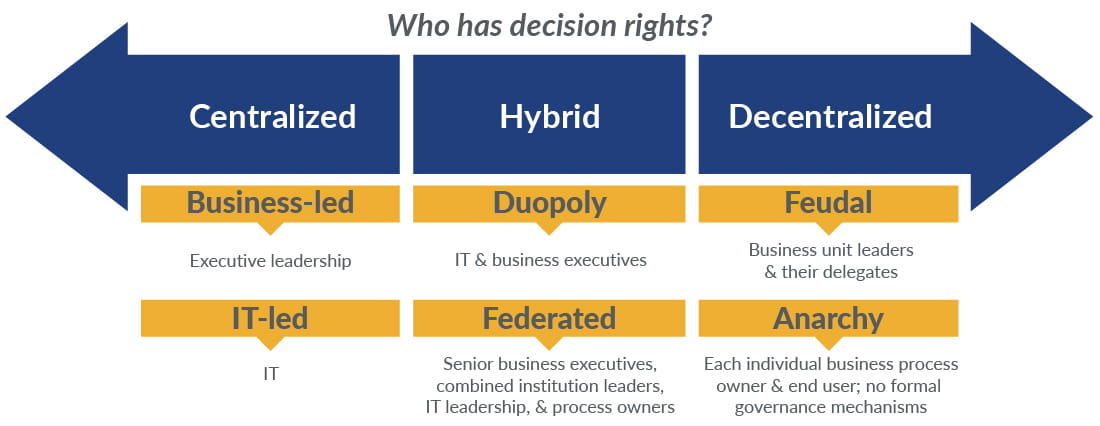The high cost of IT is a significant issue in today’s budget-constrained environment. Most higher education institutions have several different IT providers (i.e., SaaS providers, contract IT professionals providing application development, customer support, and technology integration). Larger institutions may have IT staff in a centralized organization, as well as decentralized IT staff in academic departments, finance and administration, HR, student services, and development. Additionally, affiliated organizations for alumni and athletics frequently have IT staff. In fact, one of our recent clients had IT representatives across more than 20 organizational entities.
This all comes at significant cost to institutions — but it can be mitigated, starting with IT governance.
The high cost of decentralized IT
While your user community may be satisfied with this customized approach, it comes at a high price. Consider these factors that result in a higher-cost IT environment:
- Redundant applications for shared or common needs, such as CRM, security and building access, email, and productivity solutions.
- Inability to share resources and build common skills.
- Diverse range of technology solutions, leading to additional integration and support costs.
- Loss of enterprise licensing opportunities that should be an advantage for an institution’s size and scale.
Add the impact of cloud solutions and collegewide or departmental hosting arrangements and you soon realize that everyone has their finger in the “IT pie!”
IT governance for lower costs and improved efficiencies
How can the IT support groups work more collaboratively to make decisions that impact the overall cost of IT? The answer lies in effective enterprise governance for IT decision-making, defining who’s responsible for which decisions, and how to manage what’s yours, mine, or ours.
IT governance provides the structure, processes, and tools for your organization to follow when making IT investment, strategic alignment, and resource allocation decisions. It enables you to move beyond department-specific to enterprise-wide IT decision-making.
IT governance approaches, if formalized, typically are either decentralized, centralized, or hybrid models. When not formalized, the approach may be nonexistent or chaotic. These three approaches are explained in the diagram below:

The hybrid approach — which seeks to optimize IT decision rights to meet the needs of the local department, shared, and enterprise institutional IT investment and support activities — is a popular choice. By making the distinction between these domains, IT operations, services, and applications can be optimized, and overall costs reduced.
The impact of IT inefficiencies
Answering the question of “yours, mine, or ours?” is a tip-of-the-iceberg decision: Unless your institution recognizes the need to manage the IT decision-making from a shared perspective, you’ll miss the opportunity to establish a firm foundation for IT decision-making. How can your institution grasp the cost of these inefficiencies and their impact? Consider the following when trying to minimize inefficiencies:
- Develop an institutional information technology strategy to highlight the common needs across the university. Can departmental or institutional goals and objectives be addressed using common solutions?
- Develop a comprehensive IT application inventory to determine how many IT solutions are used for common problems or needs. Would an application rationalization effort lead to reduced fragmentation — fewer applications, improved opportunities for enterprise licenses, lower costs, and greater ability to share skills and resources?
- Conduct an institutional IT benchmark study to estimate the costs associated with IT delivery in comparison to best practices. Is there a wide disparity in total costs to industry benchmarks? If there is, this is an indicator of cost inefficiencies.
- Conduct an institutionwide survey of the institution community, including IT staff, end users, academic and administrative leaders, academic staff, etc., to get anonymized input on potential gaps, strengths, and improvement opportunities.
We’ve helped many higher education institutions perform these studies and create a path forward to effective IT governance and decision-making. Contact us today — we’re ready to assist you by conducting these and similar IT initiatives.





